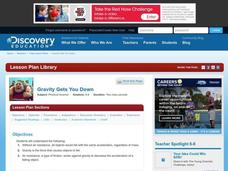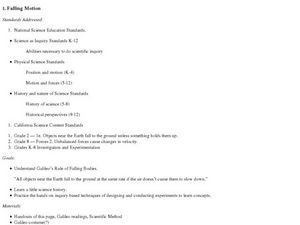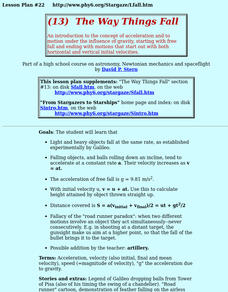Exploratorium
Falling Feather
Whether or not Galileo actually dropped balls from the Leaning Tower of Pisa, this demonstration will solidly demonstrate that objects are accelerated at the same rate, regardless of mass. You will, however, need a vacuum pump and a few...
Curated OER
Discovering Gravity: What Goes Up Must Come Down
Students observe falling objects. In this lesson about gravity, students work in groups to determine how objects fall. Students determine speed of objects falling and whether weight is a factor. Students understand the concept of gravity.
Curated OER
Gravity
Fourth graders discuss the myth of Galileo's experiments in which he threw items out the leaning Tower of Pisa to find out how fast they fell and predict what they think could happen when the two items listed on the same line are dropped...
Curated OER
Gravity Gets You Down
Students design an experiment to investigate how objects with different masses fall. In this physics lesson, students predict how these objects will fall in a vacuum tube. They write a report explaining experimental results and conclusion.
Curated OER
I'm Falling For You!
Third graders are introduced to the concept of gravity by observing different objects being dropped from a high point. In groups, they complete the same activities Galileo did and record their observations. To end the lesson, they...
Curated OER
Gravitational Acceleration
Students investigate the interdependence of mass and gravitational acceleration using computer simulation. In this physics lesson, students derive the formula for acceleration due to gravity. They calculate air resistance on falling...
Curated OER
Air: Demonstrating Its Presence and Effects
Students explore the concept of air. In this gravity lesson, students perform various experiments that deal with gravity, air resistance, and air pressure.
Curated OER
Falling Motion
Pupils design and conduct an experiment on Galileo's Rule of Falling Bodies. In this physics lesson, students collect and analyze data. They create a presentation and share it with the class.
Curated OER
The Way Things Fall
Students see that light and heavy objects fall at the same rate, as established experimentally by Galileo. They see that falling objects, and balls rolling down an incline, tend to accelerate at a constant rate a. Their velocity...
Colorado State University
Why Do Raindrops Sometimes Land Gently and Sometimes with a Splat?
A mouse can fall from large heights without injury! Air resistance is a large influence on small falling objects. In an exploratory lesson, young scholars build a raindrop bottle to compare the falling rate of different-sized objects.
Curated OER
Aristotelian and Newtonian Motion
High schoolers use a quotation from Einstein as a reference to categorize their descriptions as either Newtonian or Aristotelian. They discuss the idealized nature of the Newtonian approach. Students describe the events they observe...
Curated OER
Projectile Motion Demonstration
Learners dicusss Newton's First Law of Motion. They calculate a projectile moving horizontally and vertically at different intervals. They particpate in an experiment in which the projectile is at an angle. They record and discuss the...
Curated OER
Paper Helicopters
In this paper helicopter worksheet, learners design and experiment making a paper helicopter to explore how some things fall and how varying the size of the rotor blades affect the way a helicopter spins.
Curated OER
Force & Motion
Third graders are introduced to the concepts of force and motion. In groups, they travel between stations to analyze the effect of force and motion on various objects. They research how various careers use these concepts as well.















